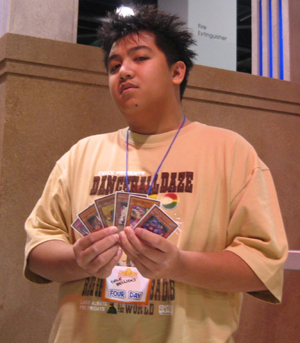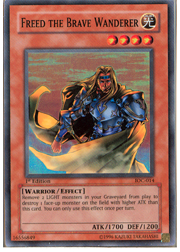Relentless aggression is usually only seen in risky players or those who just don’t know any better. If you’re completely and totally aggressive, you’ll usually leave yourself open for extreme control combinations such as Soul Exchange + Thestalos the Firestorm Monarch. Then, if you’re without defensive cards, you’ll be hard-pressed to take control of the field and regain the momentum. Sometimes waiting for a monster removal card comes at the cost of a lot of life points or monsters.
Then there’s the worry that your opponent will be able to deal with your constant attacks. The Apprentice Magician engine is great at stopping a flurry of attacks, and it can even set up a tribute for next turn. In addition, the ever-present Sakuretsu Armor can really put a hamper on getting those final attacks through.
However, the creative minds of Lazaro and Dale Bellido—two star members of Team Superfriends—came up with a new Return deck you may have already seen:
Monsters: 23
3 Cyber Dragon
3 Banisher of the Radiance
3 Bazoo the Soul-Eater
2 Magical Merchant
2 Freed the Brave Wanderer
2 Exiled Force
2 Mirage Dragon
2 Mystic Swordsman LV2
1 D. D. Assailant
1 D. D. Warrior Lady
1 Breaker the Magical Warrior
1 Sangan
Spells: 7
2 Reinforcement of the Army
1 Premature Burial
1 Nobleman of Crossout
1 Heavy Storm
1 Graceful Charity
1 Mystical Space Typhoon
Traps: 11
2 Sakuretsu Armor
2 Return from the Different Dimension
2 Bottomless Trap Hole
1 Ring of Destruction
1 Widespread Ruin
1 Call of the Haunted
1 Torrential Tribute
1 Mirror Force
 The deck hopes to capitalize on the strengths of aggressive play through monsters that can negate opposing defenses and bounce back quickly from (or nullify) the effects of Monarchs. The monster line-up focuses on getting opposing monsters and defenses out of the way in order to connect with direct attacks. Banisher of the Radiance, Exiled Force, Mystic Swordsman LV2, and D. D. Warrior Lady all help punish the general Monarch deck for playing too conservatively. However, you’ll notice that while some monsters are vulnerable to all these cards (such as Mystic Tomato), plenty will only be negated by some.
The deck hopes to capitalize on the strengths of aggressive play through monsters that can negate opposing defenses and bounce back quickly from (or nullify) the effects of Monarchs. The monster line-up focuses on getting opposing monsters and defenses out of the way in order to connect with direct attacks. Banisher of the Radiance, Exiled Force, Mystic Swordsman LV2, and D. D. Warrior Lady all help punish the general Monarch deck for playing too conservatively. However, you’ll notice that while some monsters are vulnerable to all these cards (such as Mystic Tomato), plenty will only be negated by some.
For example, Apprentice Magician and Old Vindictive Magician hate to see Mystic Swordsman LV2, but won’t really be upset with the rest. Treeborn Frog and Sangan won’t really enjoy the company of Banisher of the Radiance or D. D. Warrior Lady, but would happily do coffee with Exiled Force or Mystic Swordsman LV2. Since there’s no good way to know which monster your opponent has set, running these cards can be a terrible risk. Since the deck absolutely must get its negation in, you must be able to play the right negating monster most of the time.
That basically boils down to reading the opponent right. For a Regional, which Lazaro Bellido swept without losing a single match, the reads weren’t too hard to make. A predictable metagame and a room full of familiar faces meant that Lazaro knew before the first game how his opponents played, and whether or not they’d set bluff monsters before the more powerful ones. This luxury, however, doesn’t exist at your average Shonen Jump Championship. While you can usually guess what most of the field will be playing, you likely won’t know the majority of players you come up against. Even when the tournament is on your home turf, there are simply too many fresh faces to know how each of your opponents plays.
Therefore, to effectively play the deck, one must be able to make appropriate reads at all times. A lot of this can come down to experience. A very confident opponent who only sets one monster likely has Treeborn Frog or Mystic Tomato set, so going in with Banisher of the Radiance seems optimal. Likewise, if a player sets two back row cards, odds are against the face-down card being a Treeborn Frog. Cards like Mystical Space Typhoon and Heavy Storm come in handy in these situations. An opponent who set Scapegoat will almost never have Apprentice Magician or Mystic Tomato face down as well. Similarly, if you destroy a Torrential Tribute, odds are on a Sangan or Treeborn Frog.
However, the deck is designed to rebound from missed targets. Bazoo the Soul Eater’s primary function is to get monsters removed from play to fuel a game-winning Return from the Different Dimension. What most people don’t realize is how Bazoo can even out the playing field against a Monarch or Cyber Dragon that just came down to destroy one of your 1600 ATK beatsticks. Since the opponents have probably used their defensive cards already on Mystic Swordsman LV2 or Banisher of the Radiance, they probably destroyed the successful attacker (like a Mirage Dragon or Breaker the Magical Warrior) with their Cyber Dragon or Zaborg the Thunder Monarch.
These monsters tend to drop in perfect timing with Bazoo’s effect. Cyber Dragon tends to poke its head out and put your second monster in the grave. The Monarchs, on the other hand, are often saved for a bit later, when you’ve got three or four monsters waiting. These happen to be just enough Bazoo fodder to give his ATK the necessary values for successful attacks.
 Freed the Brave Wanderer is even better. Its effect translates into instant removal and sets up your Return from the Different Dimension perfectly, since a good chunk of the monsters you want to bring back are Light anyway. 1700 damage is also quite nice. The best part about this deck is being able to use Freed’s effect multiple times per game, through Call of the Haunted, Premature Burial, and Return from the Different Dimension. There are plenty of Light monsters that get thrown into the fray early, and a pair of Magical Merchant cards to boot.
Freed the Brave Wanderer is even better. Its effect translates into instant removal and sets up your Return from the Different Dimension perfectly, since a good chunk of the monsters you want to bring back are Light anyway. 1700 damage is also quite nice. The best part about this deck is being able to use Freed’s effect multiple times per game, through Call of the Haunted, Premature Burial, and Return from the Different Dimension. There are plenty of Light monsters that get thrown into the fray early, and a pair of Magical Merchant cards to boot.
The trap line-up for the deck is in place to protect your beatsticks from getting flattened by Cyber Dragon and big Monarchs. In addition to the defensive cards are a pair of Return from the Different Dimension cards. Return is the Swiss Army knife of the deck, allowing the wielder to solve almost any situation he or she is faced with. Whether it’s dealing the opponent huge chunks of life point damage, shredding his or her field with removal monsters and trap negators, nullifying opposing Creature Swap cards, or blocking your own life points, Return does it all. The speed and remove-from-play power of the deck gives the Return player the freedom to do anything he or she desires with the card.
Premature Burial and Call of the Haunted are probably the two most questionable cards in the deck. With five monsters that want to remove monsters from your graveyard, two monsters that want to remove themselves, and three monsters that prevent your cards from even reaching the graveyard, Premature Burial and Call of the Haunted seem risky. However, they’re very rarely dead cards because of the way most games flow. Magical Merchant effects, if they go off, will almost instantly give purpose to either one of these cards.
In addition, defenses are often expended early, destroying the Banisher of the Radiance or Mirage Dragon that was trying to get through. Call and Premature bring back these monsters in a pinch, swarming the field and knocking your opponent off balance. At this time, he or she will probably attempt a comeback using a saved Soul Exchange combo or a flurry of his or her own monsters (including Cyber Dragon). This is the optimal moment to use your Bazoo the Soul-Eater or Freed the Brave Wanderer: conveniently after the time when Call and Premature were most effective.
The deck really capitalizes on the subtle flowing nature of the game. In addition to negating almost any monster effects it wants to, the deck enforces positive situations on itself simply by both players following the standard stages of the game. Long hours of playtesting really pay off with it, since the time will grant you the ability to know when specific stages are occurring as well as making appropriate reads on the opponent. If you find yourself able to guess your opponent’s moves most of the time, this might be the deck for you.